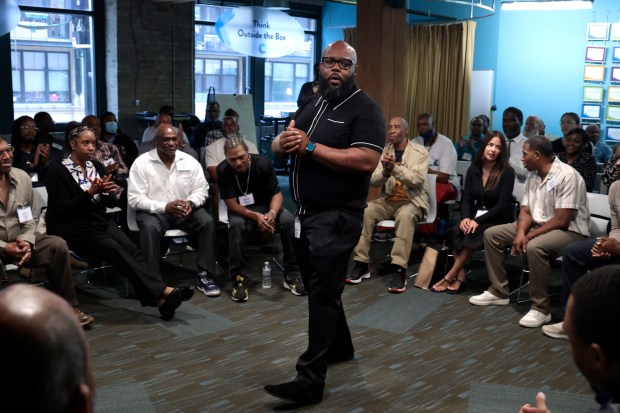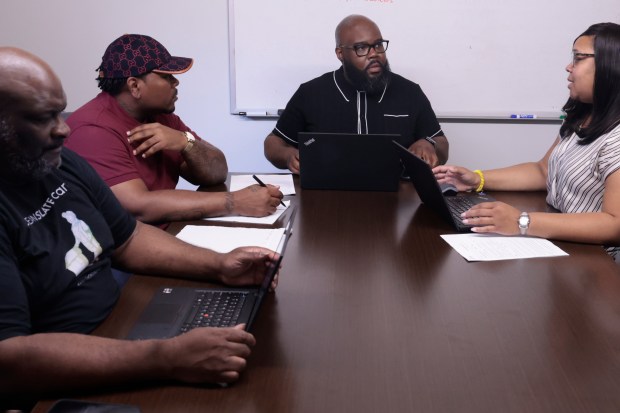Da’Sean Hillsman was 17 when he became a father in the late ’90s. By 2000, his mother had died, leaving him to make sure he and his siblings — two younger sisters, and a disabled older brother who survived being shot in the head at age 20 — stayed together.
To do that, Hillsman said, he made the choice to provide for his family by selling drugs.
“No one was hiring me,” said the now 45-year-old father of seven. “I became a new father. Three years later, my mother passed away. I had two kids, three siblings and no job. What else can I do? Either get food stamps or rob? I made the choice … to take care of my family … make sure my siblings were taken care of because I couldn’t allow them to be separated. That’s something my mother wouldn’t have wanted. Dad was alive, but wasn’t really there, so I was the man of the house. So I made the choice to make some money to keep them together.”
Hillsman said the “fast money” was plentiful, but he would eventually land in federal prison, sentenced to 10 years. Before all of that, Hillsman was looking forward to attending Grambling State University. But life happened — and he encountered circumstances similar to those faced by many in the Chicago area without resources, means or wealth.
These issues were at the center of a recently released study, “The Color of Wealth in Chicago.” Produced by the Institute on Race, Power and Political Economy at The New School in New York City and funded and released in partnership with The Chicago Community Trust, the study shows how race and ethnicity impact homeownership, access to financial tools and resources, incarceration, medical or education debt, and the COVID-19 pandemic.
Disparities across groups are stark. According to the study, data collected in 2022 showed Chicago’s white families have the highest median net wealth ($210,000), while typical Black families report no wealth ($0). Chicago’s U.S.-born Mexican families have 19% ($40,500) of a typical white family’s wealth, while foreign-born Mexican families have 3% ($6,000) and Puerto Rican families have 11% ($24,000).
As for median asset values, Black families have $20,000, foreign-born Mexican families have $26,000 and white families have $325,500.
The study also found Black families had the lowest estimated rate of home ownership at 34%, while white families had the highest at 72%, reflecting the city’s historic discrimination against people of color through redlining, racial covenants, a lack of checking or savings accounts, and payday lending, where unsecured loans with high interest rates are used as emergency financing that keeps borrowers in a cycle of long-term debt.
U.S.-born Mexican families, Black families and Puerto Rican families (29%, 30%, and 21%, respectively) were more likely to have medical debt than white families (18%). White families with a history of incarceration still had higher median family income ($75,600) than Black families with no incarceration ($38,000).
Community leaders said that although the statistics are tough to digest, they’re not surprising. Andrea Sáenz, president and CEO of The Chicago Community Trust hopes bringing the data to light will enable people to address the issues that are holding back so many families in Chicago. Similar racial wealth gap disparities have been seen in large metropolitan areas such as Boston, Miami, Los Angeles and Washington, D.C., as evidenced by the work the institute has done in past years.
Kathleen St. Louis Caliento, president and CEO of Cara Collective Chicago, a nonprofit that helps people retain gainful employment, knows what it’s like to live paycheck to paycheck. Her parents did, too. She said there is mental and emotional instability that comes with doing that. Caliento says getting folks an income does not solve all their problems, particularly when you think about the fact that many people of color are in debt, behind on payments and are victims of predatory lending.
“This report talks about the access that wealth gives you, the access that it talks about is education, health — all social determinants that are inextricably linked,” she said. “I think underscoring the importance of wealth helps people truly understand the systemic barriers that are in place particularly for folks of color who are unable to access those resources.”
Hillsman, senior manager of coaching and retention at Cara, has been working at the collective for 12 years, helping youths and the formerly incarcerated. After his involvement with the prison system, he has seen how those with felonies go for the “bottom of the barrel” jobs, thinking they are not candidates for better jobs.
“When I came out, even though I did all of this training while incarcerated, I always felt like I had this big X on my back,” he said.
But his competitive personality wouldn’t allow that X to dictate who he was or who he needed to be. He tells his clients the same thing. “Yes, we made mistakes, but I want people to start to give Black and brown people chances because we’re not all bad. We have a voice, we have skills to make this world a better place,” he said.
Darrick Hamilton, founding director of the Institute on Race, Power and Political Economy, and principal investigator of the study, said wealth is the foremost metric of financial security, a means for people to have agency, to be self-determining. Hamilton labels it a human rights economy — one where political, civil and social rights combine with economic rights to let a person be authentically free.
“You have to design, manage and implement policies in such a way that Black people are included, Indigenous people are included, because without that intentionality, the reasons why we have this wealth inequality is a political economy that is built to exclude,” he said. “We know the bootstrap narrative has never been true for any group. Our dominant framework believes if you simply get a college degree, find a partner, and stay out of trouble, that not only is that a pathway to social mobility, but also to the security associated with wealth.
“Now without a doubt, education in dual family households, and not being incarcerated is associated with better outcomes,” Hamilton said. “But when it comes to wealth, the bang for the buck of those activities for Black people is not a large gradient. The disparities persist and widen at higher strata. And here’s another point that may be shocking: Black families where they have done all those ‘right things’ have less wealth, typically, than white families that are at the lowest strata in our society, namely without a college degree.”
“The Color of Wealth in Chicago” study also surveyed people about potential policy proposals for addressing structural economic disparities. Data shows that public support for interventions on local and federal levels would have a meaningful impact on racial wealth inequities. Wealth-building options such as guaranteed income projects, a Medicare for All program, and baby bonds, which are government-issued trust accounts for newborns, garnered support from the bulk of respondents, including families at or above the median net worth.
Co-authors of the study say such policies, used in conjunction with meaningful redistributive measures that increase access to sustainable homeownership, can foster equitable entrepreneurial environments and build a justice system founded on prevention, moving the inequity needle.
“There’s always this sense that people in the corporate arena, people in government, and even those of us in the nonprofit arena, use data to make decisions,” said Karen Freeman-Wilson, president and CEO of the Chicago Urban League and former mayor of Gary. “We have to use this data to make decisions about where to deploy resources; that is my hope from this report.”
Hamilton says the disparities in wealth assets we see today are not natural. They are the result of government intervention, just like the precedent that was set with the federal government giving financial relief to households impacted during the pandemic, promoting economic security and providing resources for people to thrive.
“We know policies that can yield wealth,” he said. “We did it for white people, created a middle class where a good portion were able to generate wealth and pass it down from one generation to the next. That group didn’t emerge on its own. Chicago’s deep in historical pathways and of seeding capital and then providing a homeownership infrastructure to allow that capital to accumulate. So we know how to do this. What is problematic is that we have excluded certain people.”
Ross McDonald, aka Ro$$ Mac, a South Shore native, has been educating his community on financial literacy for years through his Maconomics platform and providing tools and actionable items to put that education in practice, such as investing in stocks, life insurance, venture capital and real estate. In early July, the Whitney Young High School alumnus held a wealth summit weekend in Chicago. A former hedge fund employee, McDonald said he started educating the community when he discovered the firm was promoting a portfolio of cash advance loan places, preying on people of color and those who are underbanked, with limited or no access to financial services and products.
“When you’re looking at where we’re at, there’s no ifs, ands or buts about it; this is all done systematically, on purpose,” McDonald said. By helping people interrogate their relationship with money, assisting them with budgeting and educating them on ways to build wealth through investments and improving credit, among other things, McDonald is doing his part to reverse the statistics found in the study.
“Distrust comes from valid reasons, whether we’re talking Jim Crow or the Freedman’s Bank, but how do we get past it,” he said, “because in order to get generational wealth, you’ve got to overcome generational trauma.”

Hillsman, a native West Sider turned South Sider, said “The Color of Wealth in Chicago” study saddened him because he said he fell victim to the the same barriers as other Chicagoans. While imprisoned, he learned from those jailed with him, partaking in programs offered inside.
When he got out, a friend led him to the Cara Collective. “I always wanted to do something to make sure that I got legit money,” he said. “I always tell people slow money is still money. With the slow money, you have to learn how to manage and budget.”
Hamilton wants to get the information in the hands of people who will agitate, advocate and promote pathways toward a different future. He knows that sounds pie in the sky, but he said that’s how to chart paradigm change. “What is clear from the report is that there is no amount of behavioral change within a group that’s going to be able to change this phenomena, except for politically organizing,” he said.
Hillsman just bought his first building, a two-flat in Washington Park. He plans to buy more buildings as investment properties, and is looking at getting into the stock market in the future, all in an effort to accumulate wealth.
“All of us want to be able to relax a little bit and have a nice bank account. This is Building 1,” he said. “I’m definitely going to try to get Building 2, 3, 4, 5, 6 and beyond. It is a family building, something my mother always wanted.”





